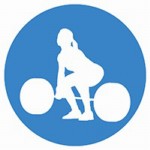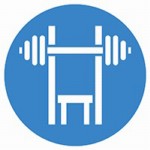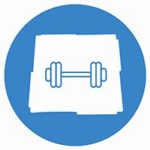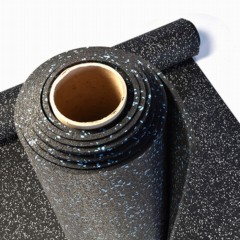Weight Room Flooring
-
$11574 /Roll You Save 29%$2.89/sqftShips Out in 1-3 Working Days SustainableShop
Options for Weight Room Flooring
When your favorite workout at home or at a fitness center involves weightlifting with free weights, you need the right weight room flooring. Proper weightlifting mats protect the subfloor while also cutting down on noise from the clanging of barbells and dumbbells.
Types of Weightlifting Mats
We have multiple formats for weight mats, simplifying the process of finding the right type for your particular needs.
- Tiles: Tiles are extremely popular as weight room mats, as they allow you to create the precise coverage size that you want to use with an easy-to-install connection system.
- Mats: Use weight room floor mats to create slightly thicker padding in certain areas of the room, such as underneath a weight bench.
- Rolls: Weight lifting flooring consisting of rolls is perfect for creating an area for lifting temporarily, and you then can roll it back up for storage after the workout session.
Benefits of Weightlifting Mats
Weight lifting mats deliver multiple benefits for use at home or in a commercial facility.
- Durability: Many of our products are made in the United States and offer multi-year warranties.
- Eco-friendly: Many of our rubber weight room flooring products consist of recycled materials, keeping old tires out of the landfill.
- Protective: Rubber padding for weightlifting protects the subfloor from damage when athletes drop their barbells or dumbbells.
- Shock-absorbing: The force of dropping a barbell can create significant vibrations against a hard floor. Our mats absorb the shock and resist vibration.
- Noise-absorbing: Cut down on the noise from clanging free weights with rubber barbell mats, avoiding disruptions to nearby locations.
- Colors: Although most rubber flooring is black, we do offer many additional design options that are more pleasing to use, including multi-color flecks against a black background.
Where to Use Weightlifting Mats
You can use our weight room flooring in a wide range of locations, thanks to the large number of products we offer and thanks to the versatility that’s available.
- Home gym: Create a workout space in a garage or basement with our tiles that can go directly over concrete.
- Shared space gym: Holding weightlifting workouts inside a building where you are sharing space with other businesses can be disruptive to the entire building, but our rubber weight mats cut down on noise.
- School gym: Because our mats are economical, it’s easy for schools to stay on budget when creating a weightlifting area.
- Significant weight: If you are focusing on bodybuilding and competitive lifting with massive amounts of weight, our drop weight lifting mats can protect the subfloor with extra padding.
- Temporary locations: If creating a weight training area in a temporary location, you don’t want to damage the subfloor. Thick mats deliver the desired protection.
- Traction: Having a sure footing is key to weight workouts, providing the leverage you need to support the barbells. Our rubber weight training mats deliver all the traction you need.
Guidelines for Selecting Weight Room Flooring
When working with free weights that you will be dropping to the floor as part of the workouts, you need to match the thickness of the rubber weight lifting mats to the amount of weight they need to absorb.
- Up to 50 pounds: Minimum 1/4 inch thick flooring
- Up to 120 pounds: Minimum 3/8 inch thick flooring
- More than 120 pounds: Minimum 1/2 inch thick flooring
- Intentionally dropped weights: Minimum 3/4 inch or 1 inch thick flooring
- Maximum vibration and noise reduction: Minimum 2 inch thick flooring
Weight Room Flooring Q&A
Is EVA foam good for gym subflooring?
It's important to realize that foam won't withstand the same level of abuse as a rubber weightlifting mat. Because of these qualities, foam is more appropriate as a casual and recreational weight room floor. It is especially popular for prone exercises.
What is the best home gym flooring for free weights?
For weight room flooring in a residential setting, rubber mats, rolls, or tiles are the best home gym floors. Pay attention to the maximum amount of weight you will be lifting and select a thickness measurement that matches it for the desired level of subfloor protection and noise reduction.
What are the 5 best flooring options for weight rooms?
For a smaller room, interlocking rubber tiles are the best floors for weight rooms. Just connect however many tiles it takes to cover the desired space. For larger spaces that can use thinner material, rubber rolls work well. For extra protection in a particular area, weight lifting mats that are thick and about 4x6 feet in size usually are ideal.
What is the best flooring for a school weight room?
Because of the high level of usage and foot traffic that school weightlifting room flooring must endure, along with the multiple sizes of weights and exercise machines in use, rubber flooring is ideal. Rubber is value-priced, and it delivers noise- and vibration-reduction that’s important in a school setting.
Is 20 mm rubber gym flooring thick enough for dropping weights?
When making use of weightlifting techniques where you will be dropping the weights after a lift, 20 mm rubber flooring can handle the impact. (A 20 mm thickness is roughly equal to 3/4 of an inch.) However, this is the minimum thickness you should select.




